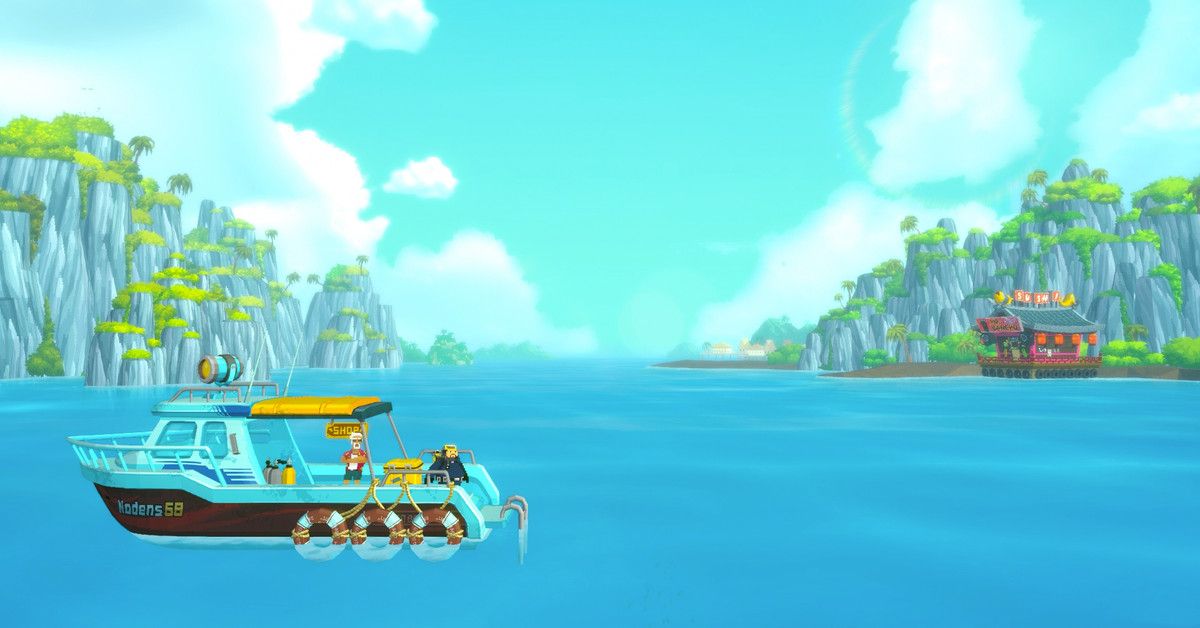Dave the Diver is a chaotic, impressive management sim dream
Share All sharing options for: Management sim Dave the Diver shouldn’t work as well as it does
Dave the Diver shouldn’t work. It is an ever-expanding Jenga tower of mechanics and task management that, somehow, never falls over. Each new character, over-the-top cutscene, and minigame feels like it should topple the whole premise, but it just never happens.
Polygon Recommends is our way of endorsing our favorite games, movies, TV shows, comics, tabletop books, and entertainment experiences. When we award the Polygon Recommends badge, it’s because we believe the recipient is uniquely thought-provoking, entertaining, inventive, or fun — and worth fitting into your schedule. If you want curated lists of our favorite media, check out What to Play and What to Watch .
Instead, what developer Mintrocket has created is a game where unabashedly having fun is the whole point, no matter how absurd the process. At its core, Dave the Diver is a combination of fishing and restaurant management sims. As the titular Dave, you go spearfishing during the day to catch ingredients to serve at a sushi restaurant at night. For most management sims, that loop is probably enough of a hook on its own.
But in Dave the Diver, that’s just the foundation. Within an in-game day or two, a graduate student shows up and sets you on missions to collect local wildlife. And then an underwater archaeologist arrives with a project. And then the otaku arms dealer shows up, followed by a boatful of militant Greenpeace activists, the Pokémon-like collectible card connoisseur, a farmer, and some pirates. It’s hard to describe what happens without sounding like a toddler “and then!”-ing their way through a bedtime story.
I’m getting ahead of myself — it’s hard not to when talking about this game. Dave goes diving a couple times a day, once in the morning and once in the afternoon, and then spends the evening running a restaurant where he turns his bounty into sushi.
By day, I swim through an ever-changing underwater environment with dozens of species of fish. The fish get hardier and more likely to attack me (which doesn’t necessarily hurt me, but it does drain my oxygen more quickly, so the end result is still a failed dive) as I swim down and to the right. The sushi I can make from the easiest-to-catch fish doesn’t earn me much, so I have to dive deeper to make real money. I can use that money to upgrade my gear — a bigger oxygen tank, a better harpoon gun, more storage for the fish I catch. Not every fish can be bagged with one shot from my speargun, though, so sometimes I have to wear them down until a button-mashing quick-time event pops up.
Meanwhile, I’ve got to remember to collect a lost package for my business partner with a shady past, find special ingredients for the upcoming Jellyfish Festival, collect parts to craft a net gun, help the grad student with a research project, and save a dolphin from pirates.
Once my tasks are done and I’ve got a full haul of fish, I head back to the sushi restaurant, where I’m in charge of everything from the decor to grinding wasabi to setting the menu. Managing the menu means finding the tastiest recipes we can make based on what I’ve recently caught. And I have to do it without preparing too much — which will see it go to waste — or running out. In other words, I’m finding the Goldilocks solution.
During service, I’m running back and forth pouring tea, delivering orders from one end of the bar to the other, and bussing plates. I have to do it quickly, or the customers get angry and leave bad reviews on the restaurant’s in-game not-Instagram account. Enough good reviews unlock the ability to hire staff to wait tables and cook.
And then, on the next dive, Dave discovers a civilization of merpeople.
Writing it down, it sounds chaotic and directionless. But it’s not. Instead, it’s a delicately balanced tower of interconnected silliness. It’s 20 minutes into a game of Jenga where there’s only one block on the bottom and holes throughout, but the tower just refuses to fall.
The glue that steadfastly holds Dave the Diver together? Its vibrant cutscenes. The taciturn chef comes up with a new recipe in an anime-inspired 30-second vignette of flashing blades and cherry blossoms. A food critic tries a specialty dish, mimicking the same scene from Ratatouille through a pixelated lens. Even when they repeat, it’s hard to skip these energetic vignettes. They’re lovingly crafted when they could be throwaway snippets. They raise the stakes for a silly upgrade to a boss battle-worthy crescendo.
It’s that constant, self-aware, tongue-in-cheek, escalating absurdity that keeps me engaged. Over the course of a few in-game days, I go from fishing to decorating to crafting a sniper rifle to kill the giant squid that stole the arms dealer’s new anime figurine.
Dave the Diver is not particularly challenging, and I can upgrade my way past any challenges without too much grinding. Running orders in the sushi restaurant is only intense until I hire a server who’s twice as fast as Dave. Getting attacked by sharks is only a sticking point until I upgrade my gun. But I’m not really a better spearfisher than I was at the beginning of the game — improving my mechanical skills isn’t the point.
What makes Dave the Diver work so well is wanting to see what comes next. In another game that just tacked on mechanics and plot devices with no plan, it could feel like the padding around a threadbare premise. But Dave’s kitchen sink approach somehow feels like a perfectly logical, if absurd, escalation — like a Tim Robinson sketch in game form. It’s a teetering pile of mechanics and minigames that never gets around to collapsing because the balancing act is just too much fun.
Dave the Diver was released on June 28 on Steam. The game was reviewed using a pre-release download code provided by Mintrocket. Vox Media has affiliate partnerships. These do not influence editorial content, though Vox Media may earn commissions for products purchased via affiliate links. You can find additional information about Polygon’s ethics policy here .
Source: Polygon


